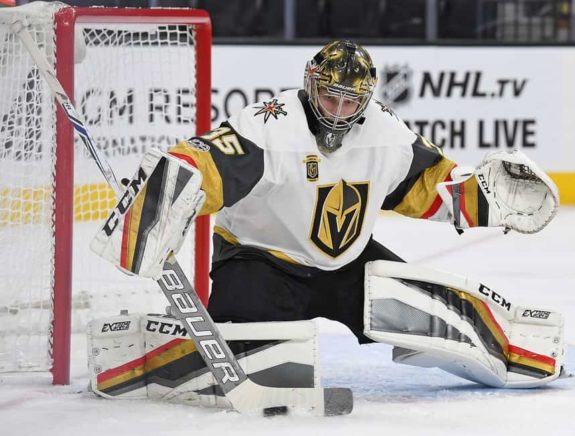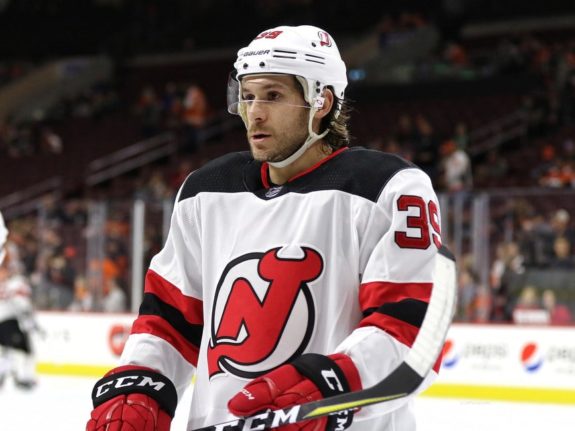The NHL free agency period is always an exciting time for hockey fans. Whether a team is a perennial Cup contender, in the process of rebuilding, or tearing it all down and tanking for the first overall pick, July 1 brings plenty of compelling action to keep every fan on the edge of their seat. As news about the most recent contract signings breaks, angst can set in for armchair general managers while they watch their favorite team hand out “questionable contracts” and find themselves wondering “why?”
Oh god, Prout’s deal is one-way? https://t.co/vGzJtU1w7w
— Kent Wilson (@Kent_Wilson) June 30, 2018
One common concern among fans is that their favorite team is handing out one-way contracts to players that are not worthy of playing in the NHL. This trepidation seems to stem from the perceived inflexibility of one-way contracts and the roster challenges they can create. But are these perceptions accurate? How do one-way contracts really differ from two-way contracts?
Player Salary
The NHL Collective Bargaining Agreement (CBA) establishes in section 11.9 (c) that a player and team may at any time enter into a two-way contract. This section can be a bit confounding, as it does not elaborate on exactly what that means or how these contracts differ from one-way contracts. Fortunately, the NHL Standard Players Contract (SPC) provides some clarity.
In examining the SPC the most important section is, perhaps unsurprisingly, the very first paragraph. Paragraph 1 of the SPC lays out many of the most basic parameters of the contractual relationship. It specifies what league year the contract is for, it establishes the effective date of the contract, and perhaps most importantly it establishes the player’s salary for the term of the contract.
A key detail of this paragraph is that it not only establishes an NHL salary but may also establish a different salary for any time not spent on the NHL active roster. This is most commonly seen as one salary value for the NHL, and another for the American Hockey League (AHL). This is what is meant by a two-way contract: the player is paid two ways, one for their time spent on the active NHL roster and a second for when they are assigned to the AHL.
The contract Oscar Dansk recently signed with the Vegas Golden Knights is a good example of these two types of salary. His contract calls for an AHL salary of $150,000 in both 2018-19 and 2019-20. However, for any time on the NHL roster, Dansk will be taking home a significantly larger paycheck of $650,000 in 2018-19 and $700,000 in 2019-20.

One-way contracts are not terribly dissimilar from two-way contracts, the most significant difference being that the contract specifies only one salary amount.
Because there is only one salary amount stipulated in a one-way contract, whether the player is playing in the NHL, the AHL, or somewhere else they will always earn the same salary. As a simple example, if a player signs a $1 million one-way contract, they will make that $1 million even if playing in the AHL. The one-year one-way contract Brian Gibbons recently signed with the Anaheim Ducks is structured exactly that way. Until recently Gibbons has been an AHL journeyman. In his seven professional seasons, he has spent only 100 games in the NHL with the majority of those games coming this past season with the New Jersey Devils. Because his contract for the 2018-19 season is one-way, if Gibbons finds himself again toiling in the American League, he will do so while still earning his NHL salary of $1 million.

Minor League Assignment
Some of the confusion about one-way contracts seems to exist around the assignability of the contracts; that is whether or not a player can be sent to the AHL or other minor and affiliated leagues. There seems to be an assumption that a one-way contract guarantees the player will be on the NHL roster for the entirety of the season. However, that is not the case.
The NHL CBA outlines a very specific and clear procedure by which a player can be sent to the minor leagues, and there is no distinction drawn between what makes a one-way and two-way contract eligible to be loaned to a minor league club. Though the CBA does very specifically designate the limitations on when and how a player may be loaned, and what the necessary steps are, whether or not they have a one-way or two-way contract is not a consideration.
Though players on two-way contracts are demoted to the minor leagues more frequently, there have been some notable examples of players who were demoted despite being on one-way contracts. During the 2015-16 season, Nikita Nikitin was demoted by the Edmonton Oilers to their AHL affiliate in Bakersfield despite the fact he carried a one-way contract worth $4.5 million. Nikitin played only 11 games in the NHL that season, and another 30 in the AHL before returning to the KHL for the 2016-17 season.

During the 2015-16 season, the Chicago Blackhawks had a somewhat unique situation in that they had two veterans on one-way contracts playing for their AHL affiliate. Bryan Bickell spent more than half the season in the AHL with the Rockford IceHogs and was eventually joined there by Rob Scuderi until the latter was traded to Los Angeles for Christian Ehrhoff who was also playing in the AHL at the time despite his one-way contract.
So what effects does a player on a one-way contract being demoted have if they are still paid their NHL salary?
Cap Implications
Demoting a player on a two-way contract typically clears the entire cap hit for the team. For players on one-way contracts, things get more complex.
Section 50.5 (d)(i)(B)(6) of the NHL CBA describes how to calculate the salary cap hit for a one-way salary when demoted: “For any Player on a One-Way NHL SPC who is Loaned to a club in another professional league, the Averaged Amount of such SPC less the sum of the Minimum Paragraph 1 NHL Salary and $375,000 for that League Year (e.g., $900,000 in 2012-13) for the period during which such Player is Loaned to such professional league.” This means that a player whose salary is less than the sum of the CBA’s established minimum salary for that season and $375,000 would have their entire cap hit erased when demoted. For players whose cap hit is in excess of the minimum salary plus $375,000, a portion of their contract will continue to count against the cap once they are demoted.
So how did this affect Edmonton’s cap situation when they demoted Nikitin?
For the 2015-16 season, the minimum salary was $575,000. So, we add the minimum salary of $575,000 and the specified $375,000 to determine that the maximum cap relief in 2016-17 was $950,000. Because Edmonton could only see a maximum of $950,000 cap relief once Nikitin was demoted to the AHL, $3.55 million of his contract was still counted against Edmonton’s salary cap.
What about current players like Gibbons and Prout?
For the 2018-19 season, the league minimum salary is $650,000. Again, we can add the minimum salary of $650,000 and the specified $375,000 to arrive at a maximum cap relief for the 2018-19 season of $1.025 million. Neither Gibbons nor Prout has a cap hit that exceeds this amount. So, while their teams would still be on the hook for their entire NHL salary, their entire cap hit will be wiped out if they are demoted to the AHL.

The key takeaway here is if a player’s one-way contract has an annual value less than the minimum salary plus $375,000 then the risk is relatively low. Demoting the player clears the entire cap hit and opens up a roster spot for another player. If the contract’s annual value is greater than the minimum salary plus $375,000, then the risk grows with the cap hit, and the benefits to the team shrink. Demoting the player may clear a roster spot, but the cap relief may be minimal.
At the end of the day giving out one-way contracts to the Dalton Prouts and Brian Gibbons of the world probably aren’t going to hurt your favorite team. But if they gamble on a big contract for players who are unproven or have failed to be live up to expectations, like Nikitin, they could be in some real trouble.